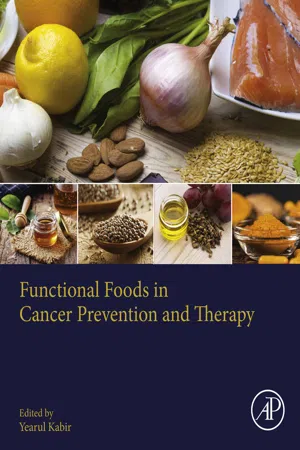
- 522 pages
- English
- ePUB (mobile friendly)
- Available on iOS & Android
Functional Foods in Cancer Prevention and Therapy
About this book
Functional Foods in Cancer Prevention and Therapy presents the wide range of functional foods associated with the prevention and treatment of cancer. In recent decades, researchers have made progress in our understanding of the association between functional food and cancer, especially as it relates to cancer treatment and prevention. Specifically, substantial evidence from epidemiological, clinical and laboratory studies show that various food components may alter cancer risk, the prognosis after cancer onset, and the quality of life after cancer treatment. The book documents the therapeutic roles of well-known functional foods and explains their role in cancer therapy.The book presents complex cancer patterns and evidence of the effective ways to control cancers with the use of functional foods. This book will serve as informative reference for researchers focused on the role of food in cancer prevention and physicians and clinicians involved in cancer treatment.- Discusses the role of functional foods in cancer therapy- Presents research-based evidence of the role of herbs and bioactive foods in cancer treatment and prevention- Provides the most current, concise, scientific information regarding the efficacy of functional foods in preventing cancer and improving the quality of life- Explores antioxidants, phytochemicals, nutraceuticals, herbal medicine and supplements in relation to cancer prevention and treatment- Contains a clinical approach to the use of functional foods to prevent and treat cancer- Emphasizes the role and mechanism of functional foods, including the characterization of active compounds on cancer prevention and treatment
Frequently asked questions
- Essential is ideal for learners and professionals who enjoy exploring a wide range of subjects. Access the Essential Library with 800,000+ trusted titles and best-sellers across business, personal growth, and the humanities. Includes unlimited reading time and Standard Read Aloud voice.
- Complete: Perfect for advanced learners and researchers needing full, unrestricted access. Unlock 1.4M+ books across hundreds of subjects, including academic and specialized titles. The Complete Plan also includes advanced features like Premium Read Aloud and Research Assistant.
Please note we cannot support devices running on iOS 13 and Android 7 or earlier. Learn more about using the app.
Information
Natural remedies and functional foods as angiogenesis modulators
Abstract
Keywords
Angiogenesis definition and background
Table of contents
- Cover image
- Title page
- Table of Contents
- Copyright
- Contributors
- Author biographies
- 1: Natural remedies and functional foods as angiogenesis modulators
- 2: Targeted cancer therapy with bioactive foods and their products
- 3: Natural compounds and anticancer effects: The whole is greater than the sum of its parts
- 4: Relationship between functional food and tumor metabolism
- 5: Adiponectin-enhancing dietary constituents in cancer prevention
- 6: Lentils (Lens culinaris L.): A candidate chemopreventive and antitumor functional food
- 7: Evidence for anticancer properties of honey with emphasis on mechanistic overview
- 8: Curcumin in cancer prevention and therapy
- 9: Usefulness of grape seed polyphenols in the prevention of skin cancer: A mini review
- 10: Indian herbal medicine and their functional components in cancer therapy and prevention
- 11: Antioxidant phytochemicals in cancer prevention and therapy—An update
- 12: Prooxidant anticancer activity of plant-derived polyphenolic compounds: An underappreciated phenomenon
- 13: Plant-based products in cancer prevention and treatment
- 14: Overview of probiotics in cancer prevention and therapy
- 15: Plant-derived functional foods with chemopreventive and therapeutic potential against breast cancer: A review of the preclinical and clinical data
- 16: Complementary and alternative medicine (CAM) in head and neck malignancy and its impact on treatment
- 17: Targeting cancer stem cells with phytoceuticals for cancer therapy
- 18: Nutrigenomics and functional food: Implications for cancer prevention and treatment
- 19: Harnessing personalized nutrigenomics for cancer prevention and treatment through diet-gene interaction
- 20: Functional foods in cancer prevention and therapy: Recent epidemiological findings
- 21: Food and nutrition in cancer survivors: LONGLIVE® lifestyle—Current guidelines and mechanisms
- Index